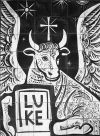
THE GOSPEL OF LUKE
The Visitation: Lk 1,39-56
This scene begins with Mary's journey to Elizabeth (verse 39) and ends with her departure (verse 56).
Luke in this scene brings together the two expectant mothers as well as the children in their wombs. This scene forms a hinge between the two announcements of the births and the two birth scenes. It is in particular a commentary about Mary herself who is the focus of the scene.
Verses 39 and 40 set up the scene as Mary arrives at the house of Zechariah (the only mention of him in this scene) and greets Elizabeth. Verse 41 then prepares us for Elizabeth's praise of Mary which follows in verses 42-45. Recalling Esau and Jacob wrestling in the womb of Rebekah (Gen 25,22), now John in Elizabeth's womb leaps in recognition of the child in Mary's womb. John's role as the forerunner is anticipated. Elizabeth is filled with the Holy Spirit as will be Zechariah before he proclaims the Benedictus (1,67).
"Blessed" in verse 42 indicates praise of Mary and her child as recognised by Elizabeth's child. There are allusions here to two women who in the past saved Israel, Jael in Judges 5,24 ("Most blessed of women is Jael") and especially Judith in Judith 13,18.
In verse 43, the unborn Jesus is already called "Lord". This will be Luke's most common title for Jesus. It will be the title used by Christians for Jesus following the resurrection. There is also the note of joy in verse 44.
The second blessed which follows in verse 45 is that of the Beatitudes (6,20), the blessing celebrating a way of life (Ps 1,1) which is fulfilled by Mary. She would be included in Jesus' comment in 11,28, "blessed are those who hear the word of God and keep it". Mary is thus being portrayed as a model disciple of her son, someone who is totally obedient to the word of God.
The second part of the scene, 1,46-56, is then Mary's praise of God, her Magnificat. It begins simply with "Mary said" in contrast to Elizabeth's exclamation in verses 41-42 and in contrast to Zechariah later (1,67).
Verse 56 has Mary going home just before the birth of John. That might seem strange but it is necessary for the evangelist to remove Jesus from the scene before John is born.
The final comment I made was about the relationship between Elizabeth and Mary. They could easily be bitter rivals like Sarah and Hagar (among others) in Genesis or Peninnah and Hannah in 1st Samuel. Instead they are examples of loving co-operation much as we see with Naomi and Ruth in the book of Ruth.
We can now return to the main page.
